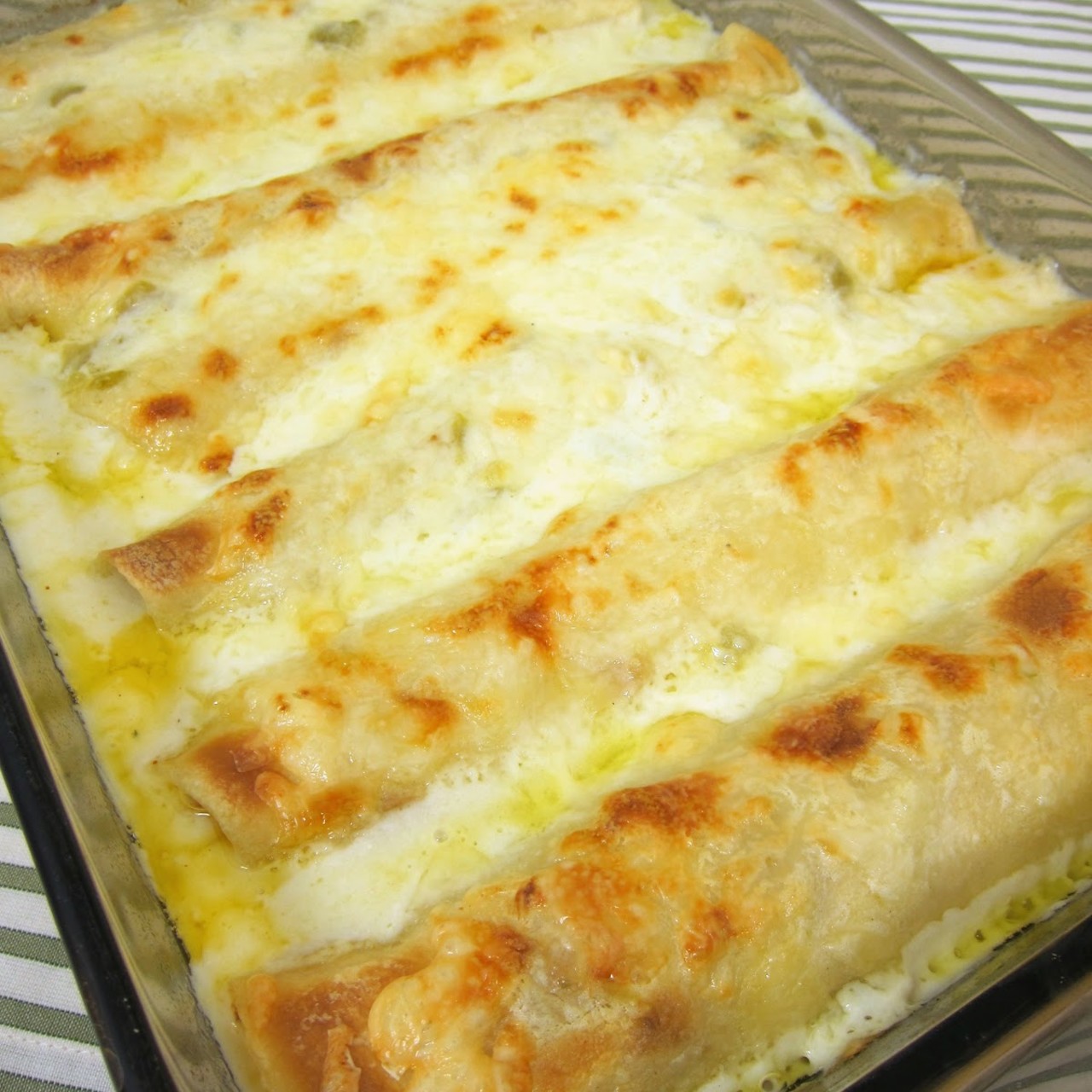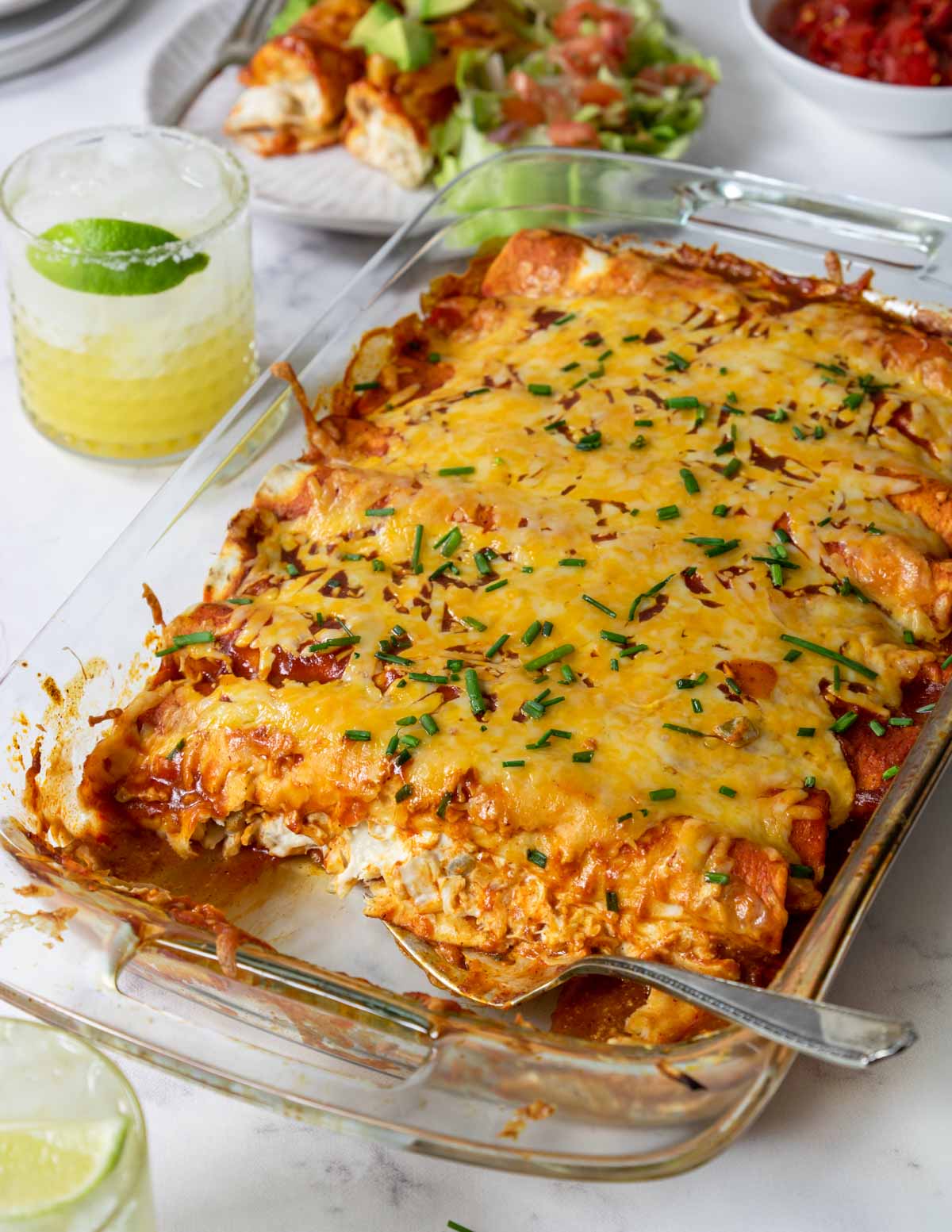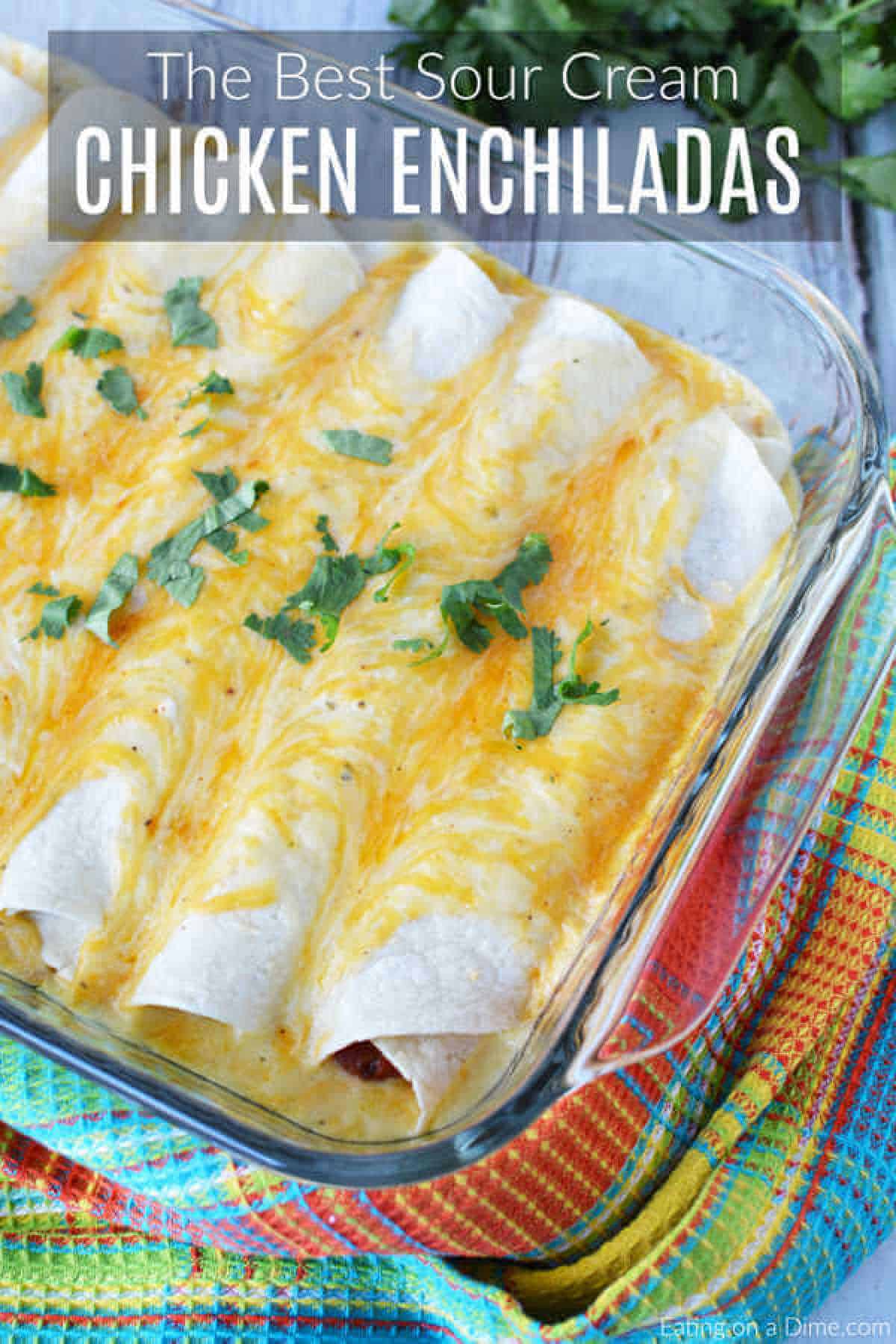Creamy Chicken Enchiladas: How To Achieve The Perfect Texture
Creating a Creamy Sauce
Choosing the Right Ingredients
Creating a Creamy Sauce
To achieve the proper creamy sauce for these chicken enchiladas, it’s crucial to choose the right components and follow a particular process.

Choosing the Right Ingredients
1. Base: The base of the sauce could be both a roux (equal elements butter and flour) or a béchamel (butter, flour, and milk). For a richer flavor and a thicker sauce, use a roux.
2. Liquids: Milk, cream, or a mixture of each can be utilized. Whole milk or heavy cream will create a thicker, creamier sauce.
3. Cheese: Cream cheese or sour cream could be added for further creaminess and richness.
four. Seasonings: Salt, pepper, garlic, and herbs can be utilized to reinforce the flavour of the sauce.
Process of Creating a Creamy Sauce
1. Create a roux or béchamel: Heat butter in a saucepan and whisk in flour. Cook for 1-2 minutes for a roux, or progressively whisk in milk for a béchamel until thickened.
2. Add liquids: Slowly whisk in milk or cream until the specified consistency is reached.
three. Add cheese: Once the sauce is simmering, whisk in cream cheese or sour cream until melted and incorporated.
four. Season: Season the sauce to style with salt, pepper, garlic, and herbs.
Balancing Flavors
When creating a creamy sauce, the secret’s to begin with a great base. A simple roux, made with equal parts butter and flour, is a good way to begin out. Once the roux is cooked, you probably can add milk or cream to create a easy and creamy sauce.
To stability the flavors in a creamy sauce, it could be very important think about the opposite elements within the dish. For instance, if you are making a creamy chicken enchilada sauce, it can be best to add some spices to steadiness out the creaminess. Some good spices to make use of embrace chili powder, cumin, and oregano.
It can also be essential to contemplate the feel of the sauce. A creamy sauce should be easy and velvety, however it should not be too thick. If the sauce is simply too thick, you’ll have the ability to thin it out by adding more milk or cream.
With somewhat apply, you probably can easily create a creamy sauce that is both delicious and well-balanced.
Achieving the Perfect Consistency
In the culinary realm of creamy sauces, attaining the perfect consistency is akin to crafting a culinary masterpiece. This delicate steadiness of richness and fluidity requires a keen understanding of the elements and methods concerned. Whether you need a velvety clean sauce on your enchiladas or a luscious topping on your pasta, the key lies in mastering the art of making a harmonious emulsion.
To embark on this delectable journey, let us start with the muse: choosing the proper components. The coronary heart of any creamy sauce lies within the dairy element, which might vary from entire milk to heavy cream. Opting for a higher fats content material will yield a richer, more indulgent sauce. Additionally, think about incorporating flavorful ingredients such as grated Parmesan cheese, crumbled blue cheese, or herbs like thyme and oregano to boost the taste profile.
Once your elements are assembled, the approach employed in preparing the sauce performs a pivotal role in attaining the specified consistency. The conventional method includes a roux, a mixture of equal parts butter and flour, which is cooked gently to create a thick paste. Gradually whisking in the dairy component permits the starch granules in the flour to absorb the liquid and type a secure emulsion. This process requires endurance and fixed stirring to forestall lumps and guarantee a clean texture.
Another strategy to crafting a creamy sauce is the béchamel methodology, which depends on a direct incorporation of the dairy right into a roux. Unlike the standard technique, the béchamel method involves slowly including the dairy whereas continuously whisking to create a smooth, lump-free sauce. This technique is especially well-suited for sauces that require a lighter, more delicate texture.
Achieving the proper consistency in a creamy sauce additionally involves paying shut attention to the temperature. Overheating can cause the sauce to separate or curdle, leading to an unappetizing texture. Maintaining a delicate heat all through the cooking course of allows the elements to emulsify gradually with out breaking down.
Incorporating thickeners corresponding to cornstarch or flour can further enhance the consistency of a creamy sauce. These starches take up excess liquid, offering a thicker, extra viscous texture. It is essential to use these thickeners sparingly, as excessive quantities can result in a gummy or pasty sauce.
Finally, the art of creating a creamy sauce extends past the initial preparation. Reheating the sauce requires equal care to hold up its delicate stability. Overheating or exposing the sauce to excessive temperature fluctuations can disrupt the emulsion and compromise its texture. Gently reheating the sauce over low heat, while stirring continuously, ensures that it retains its velvety smoothness.
Mastering the intricacies of creamy sauce creation is a culinary endeavor that requires persistence, precision, and a eager palate. By understanding the principles of emulsification, deciding on the appropriate ingredients, and employing the right strategies, you’ll have the ability to elevate your culinary creations to new heights of lusciousness.
Preparing the Chicken
Selecting the Best Chicken Type
When making ready the chicken for your Creamy Chicken Enchiladas, you need to be sure to choose the best chicken kind and prepare it properly. Here are some tips:
Selecting the Best Chicken Type:
– Boneless, skinless chicken breasts are your greatest option for this recipe. They are lean and prepare dinner evenly.
– You can also use boneless, skinless chicken thighs if you choose. They are a little more flavorful and juicy, however they could take somewhat longer to cook dinner.
– Avoid using frozen chicken, as it won’t cook as evenly.
Preparing the Chicken:
– Season the chicken breasts or thighs with salt and pepper.
– Heat a big skillet over medium heat. Add the chicken to the skillet and cook dinner till browned on all sides.
– Reduce warmth to low and continue cooking the chicken until it’s cooked via. This will take about 10-12 minutes for chicken breasts and 12-15 minutes for chicken thighs.
– Remove the chicken from the skillet and let it relaxation for a few minutes before shredding or cutting it into pieces.
Cooking Techniques for Tenderness
Preparing the Chicken
1. Use boneless, skinless chicken breasts for the most tender and flavorful outcomes.
2. Pound the chicken breasts to a good thickness of about half inch. This will help them prepare dinner evenly and stop them from drying out.
three. Season the chicken breasts with salt, pepper, and your favorite seasonings.
four. Cook the chicken breasts over medium warmth till they’re cooked through and not pink within the middle.
Cooking Techniques for Tenderness
1. Brining: Soaking the chicken breasts in a salt water answer for several hours earlier than cooking will help them retain moisture and turn out to be more tender.
2. Marinating: Marinating the chicken breasts in a flavorful liquid for a quantity of hours or in a single day will help them take in flavor and turn out to be extra tender.
3. Slow cooking: Cooking the chicken breasts in a slow cooker on low heat for several hours will result in the most tender and flavorful chicken.
four. Using a meat thermometer: Cooking the chicken breasts to the right inside temperature is essential for reaching tenderness. Use a meat thermometer to verify the interior temperature of the chicken breasts; they want to be cooked to an internal temperature of one hundred sixty five levels Fahrenheit.
Seasoning for Flavor
– To put together the chicken, start by seasoning it with salt and pepper.
– Then, heat some olive oil in a big skillet over medium warmth and add the seasoned chicken.
– Cook the chicken till it’s cooked by way of and browned on all sides.
– Once the chicken is cooked, remove it from the skillet and let it relaxation for a couple of minutes before chopping it into small pieces.
– To season the chicken for taste, you can use a wide range of different spices and herbs.
– Some well-liked choices include paprika, chili powder, cumin, oregano, and thyme.
– You can also add some chopped garlic and onion to the skillet together with the spices for further flavor.
– Once you’ve added the spices and herbs, stir the chicken nicely to ensure that it’s evenly coated.
– Then, prepare dinner the chicken for a couple of extra minutes until it is cooked by way of and the spices are aromatic.
Assembling the Enchiladas
Layering the Tortillas
In an oblong baking dish, spread half cup of the cooked enchilada sauce on the bottom of the dish.
Use tongs to submerge tortillas into the good and cozy sauce, coating them however not over-saturating them.
Place a small handful of the chicken-cheese combination in a line, a little beneath the middle of a tortilla.
Roll up the tortilla, as tightly as potential without ripping.
Nestle the filled tortillas in the dish, seam-side down. Repeat with the remaining tortillas, arranging them side by aspect.
Top the enchiladas with the remaining sauce evenly.
Sprinkle the remaining Mexican cheese mix evenly over the sauce.
Filling and Rolling
– Spread the sauce along the bottom of a greased 9×13 baking dish.
– Fill a tortilla with about half of cup of the chicken combination and roll it up. Place the enchilada seam facet down within the prepared baking dish.
– Repeat with the remaining tortillas. Cover the enchiladas with the remaining cheese sauce.
– Bake for 20 minutes, or until the cheese is melted and bubbly. Serve with sour cream, guacamole, and salsa, if desired.
Toppings and Garnish
To assemble the enchiladas, spread a skinny layer of enchilada sauce within the bottom of a lightly greased 9×13 inch baking dish. Fill every tortilla with about half of cup of the chicken mixture, and roll up tortillas tightly. Place enchiladas seam facet down within the baking dish.
Pour the remaining enchilada sauce over the enchiladas, and sprinkle with the cheese. Bake for 20-25 minutes, or until the cheese is melted and bubbly and the enchiladas are heated through.
Top together with your favourite toppings corresponding to sour cream, guacamole, salsa, and green onions.
Baking and Serving
Baking Techniques for Even Cooking
The goal of baking is to produce an evenly cooked, flavorful, and aesthetically pleasing dish. Achieving this requires cautious consideration to strategies that make sure the food is cooked by way of without overcooking, and that its flavors are absolutely developed and harmonized.
One of crucial strategies for even cooking is preheating the oven before putting the meals inside. This allows the oven to reach the specified temperature and maintain it throughout the cooking process, making certain that the meals cooks evenly and on the right fee.
The choice of baking dish is also crucial. A dish that’s too small won’t allow the meals to cook evenly, while a dish that’s too giant will cause the food to cook too rapidly on the surface and undercook on the inside. The best baking dish must be just giant enough to accommodate the meals without overcrowding it.
Finally, the baking time and temperature must be fastidiously managed. Overcooking can dry out the food and destroy its flavors, while undercooking can go away it unsafe to eat. The correct baking time and temperature will differ depending on the type of food being cooked, and you will need to seek the assistance of a recipe or different reliable supply for the appropriate specifications.
By following these techniques, it is attainable to realize evenly cooked, flavorful, and visually appealing baked dishes that can delight any taste bud.
Serving Temperature
Serving Temperature
The best serving temperature for creamy chicken enchiladas is a hundred sixty five levels Fahrenheit (74 levels Celsius). This temperature ensures that the chicken is cooked by way of, the cheese is melted and bubbly, and the sauce is heated evenly. To verify the temperature, insert a food thermometer into the middle of the enchilada.
If the enchiladas are not sizzling enough, they are often reheated in the oven or microwave. To reheat within the oven, preheat the oven to 350 degrees Fahrenheit (177 levels Celsius) and place the enchiladas in a baking dish. Cover the dish with foil and bake for 15-20 minutes, or till heated via.
To reheat within the microwave, place the enchiladas on a microwave-safe plate and canopy them with a paper towel. Heat on high for 1-2 minutes, or till heated through.
Presentation Ideas
Baking and Serving
Once assembled, place the enchiladas seam-side down in a lightly greased 9×13 inch baking dish. Pour the remaining sauce over the enchiladas and sprinkle with the remaining cheese.
Bake in a preheated 375°F oven for 20-25 minutes, or till the cheese is melted and bubbly and the sauce is heated via.
Remove from the oven and let rest for 5-10 minutes before serving.
Presentation Ideas
Serve the enchiladas together with your favorite toppings, similar to:
– sour cream chicken enchiladas sauce cream
– Guacamole
– Pico de gallo
– Sliced avocado
– Shredded lettuce
– Chopped cilantro

For a extra elegant presentation, you probably can organize the enchiladas on a platter and drizzle them with a creamy sauce.
You can even garnish the enchiladas with recent herbs, similar to parsley, cilantro, or basil.

